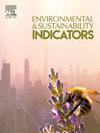Environmental DNA metabarcoding reveals complex interactions between natural capital in orchards: Insights into arthropod community dynamics and foraging diversity
IF 5.4
Q1 ENVIRONMENTAL SCIENCES
引用次数: 0
Abstract
Natural vegetation fragments in agroecosystems often support relatively diverse arthropod communities and the ecosystem services they deliver. Unfortunately, these natural fragments are not typically accounted for in farm management, partly due to the challenges in applying conventional approaches (e.g., sweep netting) to monitor arthropod-plant interactions at the vast scale of agroecosystems. Increasingly, environmental DNA (eDNA) metabarcoding—a molecular method capable of amplifying trace amounts of DNA—has been applied in agriculture to monitor arthropod-plant interactions. Here, we used pan traps and eDNA metabarcoding of pan-trap water to measure the response of two environmental indicators—orchard arthropod community diversity and arthropod-plant foraging diversity—to the presence of adjacent natural vegetation and crop flowering intensity. We sampled six orchards, adjacent to either pasture habitat or natural vegetation, across four time points during crop flowering. In total, we collected more than 2000 arthropod specimens and identified over 250 plant taxa from eDNA, including crops, weeds and native Australian flora. Adjacent habitat type did not significantly influence arthropod species richness or abundance. However, orchards adjacent to natural vegetation showed increased capture rates of beneficial native bee (Lasioglossum sp.) and hoverfly (Melangyna viridiceps) species. Additionally, pan traps in orchards adjacent to natural vegetation contained more than double the number of foraging plant genera at low crop flowering compared to pan traps at orchards adjacent to pasture. Our findings highlight that eDNA-based monitoring can enhance our understanding of the biological processes that influence crop productivity while also revealing the complex interactions between different components of natural capital in agroecosystems.

环境DNA元条形码揭示了果园自然资本之间复杂的相互作用:节肢动物群落动态和觅食多样性的见解
农业生态系统中的天然植被片段通常支持相对多样化的节肢动物群落及其提供的生态系统服务。不幸的是,这些自然片段在农场管理中通常不被考虑在内,部分原因是在应用传统方法(如扫网)来监测大规模农业生态系统中节肢动物-植物相互作用方面存在挑战。环境DNA (eDNA)元条形码-一种能够扩增微量DNA的分子方法-已越来越多地应用于农业中,以监测节肢动物与植物的相互作用。本研究利用盘式捕集器和盘式捕集器水的eDNA元编码技术,测量了果园节肢动物群落多样性和节肢动物-植物觅食多样性两个环境指标对邻近自然植被和作物开花强度的响应。我们在作物开花期间的四个时间点对六个果园进行了采样,这些果园要么毗邻牧场栖息地,要么毗邻天然植被。我们共收集了2000多个节肢动物标本,并从eDNA中鉴定了250多个植物分类群,包括作物、杂草和澳大利亚本土植物群。邻近生境类型对节肢动物物种丰富度和丰度影响不显著。然而,靠近天然植被的果园对有益的本地蜜蜂(Lasioglossum sp.)和食蚜蝇(Melangyna vi滑稽)的捕获率增加。此外,在靠近天然植被的果园中设置的盘式诱捕器在作物低花期捕获的觅食植物属数量比在靠近牧场的果园中设置的盘式诱捕器多一倍以上。我们的研究结果强调,基于edna的监测可以增强我们对影响作物生产力的生物过程的理解,同时也揭示了农业生态系统中自然资本不同组成部分之间复杂的相互作用。
本文章由计算机程序翻译,如有差异,请以英文原文为准。
求助全文
约1分钟内获得全文
求助全文
来源期刊

Environmental and Sustainability Indicators
Environmental Science-Environmental Science (miscellaneous)
CiteScore
7.80
自引率
2.30%
发文量
49
审稿时长
57 days
 求助内容:
求助内容: 应助结果提醒方式:
应助结果提醒方式:


